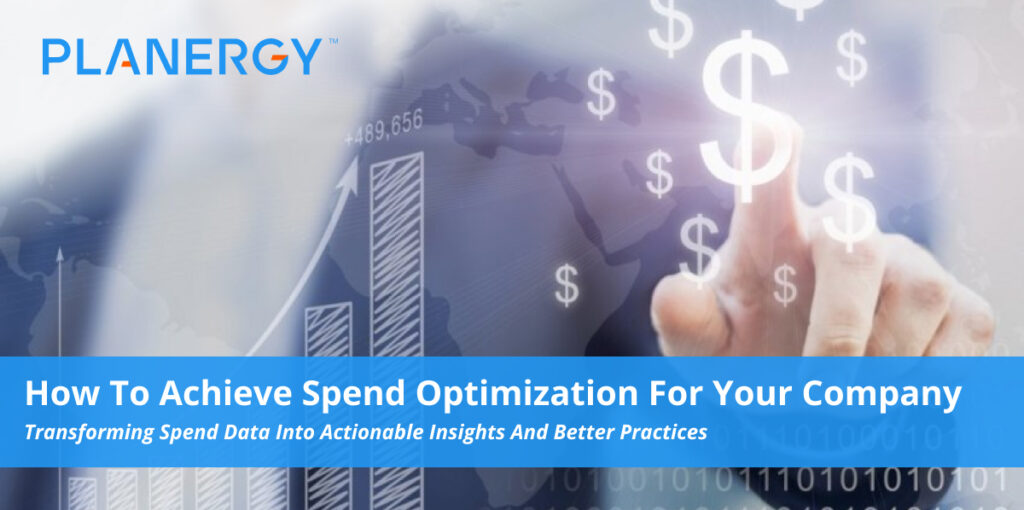Doing business in the “new normal” of the post-COVID era is defined by uncertainty—and, more importantly, the ways in which companies adjust their practices and strategies to mitigate it. One of the most important areas to address is procurement in general and spend optimization in particular.
Now more than ever, finding ways to optimize spend is crucial to every part of your business. From protecting your bottom line and business continuity to building value through continuous improvement and insight-driven decision making, moving beyond spend management to spend optimization can help your company survive and thrive in a complex and uncertain global economy.
Why You Need a Spend Optimization Strategy
Even before the need to adapt to major disruptors such as COVID-19, Brexit, or natural disasters, most companies had some type of spend management strategy in place to secure cost savings—usually through a mix of the aggressive pursuit of the lowest possible pricing and a focus on supply chain efficiency. Procurement served as a cost center, where the need to save money wherever possible to protect the bottom line was job one.
Doing business in today’s economy, however, demands a more proactive and strategic approach. The growing availability of digital transformation tools, an increased focus on data management and workflow optimization, and the potential to harvest rich and actionable insights from spend data have elevated the procurement function to a much more strategic role.
To compete effectively, modern organizations are redefining their spend management strategies, taking a closed-loop spend management approach that’s collaborative, centralized, and focused on:
- Total cost of ownership (TCO) and return on investment (ROI) over cost savings alone.
- Building agility and resilience into all procurement workflows by establishing and enforcing spend management best practices for both direct and indirect spend, as well as implementing digital transformation tools to support process optimization.
- Practicing both cost savings and cost avoidance strategies to build value, reduce risk, and improve working capital management.
- Leveraging real-time data analysis and centralized data management to collect actionable insights that drive better reporting, forecasting, and decision-making.
- Aligning procurement practices and goals with organizational goals and priorities, and using intelligence gathered from spend analysis to guide overall business practices.
Adopting a spend optimization mindset helps companies of all sizes and types mitigate or even eliminate existing risks, insulate against unforeseen risk exposure, and gain the agility and resilience required to preserve business continuity in today’s complex and competitive global marketplace.
Implementing your shiny new spend optimization strategy and taking advantage of the opportunities for cost savings will be difficult (if not impossible) if you’re still using outdated software and fragmented data management tools—or worse yet, still relying on manual, paper-based workflows.
Best Practices for Spend Optimization
Procurement has a front-row seat when it comes to identifying the areas where your organization can get the best possible value for their money. Following a few essential best practices can help every procurement organization streamline their spend and begin the transition to a more strategic, value-focused role for their companies.
1. Create a Strategic Sourcing Plan
As with so many other areas of modern business, the future of spend management is digital, data-driven, and strategic rather than tactical. Establishing clear goals for your spend, along with internal controls and practices that reduce risk while building value and cutting costs, takes careful planning.
Understanding your current needs and capabilities; uncovering deficiencies and inefficiencies in your processes; targeting and eliminating risk; measuring and improving performance over time.
These are the hallmarks of a truly strategic sourcing plan—one that will help your procurement team gain a maximum return on every dollar spent and focus not only on immediate costs, but TCO over time and the impact of each purchase on your company’s goals, competitive advantage, and bottom line.
The more well-developed your sourcing strategy is, the more effective your spend optimization will be.
2. Identify and Pursue Opportunities for Spend Optimization
While every dollar spent by your company has the potential to build value and provide a healthy return on investment, different companies have different priorities—and different opportunities to capture more savings and value through targeted improvements in their spend.
For example, a software provider whose primary product is a suite of marketing tools deployed and managed using the software-as-a-service (SaaS) model will likely prioritize spend optimization in areas considered “indirect spend” by a traditional manufacturing company relying on physical raw materials to produce finished goods.
(Which is not to say indirect spend isn’t, or shouldn’t be, a priority for companies. In fact, optimizing indirect spend represents a major (and too-long overlooked) opportunity for every company who wants to shift their procurement to a more strategic footing while saving money and generating value.)
In addition, an effective category management strategy is essential regardless of the type or size of your business. Proactive, data-driven category management keeps budgets where they should be and prevents scope creep while still allowing category managers the flexibility to pursue new opportunities for savings or value when collaborating with suppliers.
Other areas to consider when looking for spend optimization opportunities include:
Marketing Spend
- Reusing and repurposing content across channels reduces expenses while building value through greater exposure and more impressions.
- Using data analysis and performance metrics to adjust seasonal marketing spend to target those marketing channels (online, radio, TV, etc.) that have historically generated the biggest ROI allows for more robust campaigns and a greater number of conversions.
- Spend analysis can help companies identify key suppliers that are also potential partners in mutually-beneficial shared marketing initiatives.
Information Technology (IT) Spend
- Reviewing service-level agreements (SLAs) and streamlining services accordingly (by replacing on-premises hardware, software, and support with cloud-based alternatives, for example) can cut costs without impacting performance or functionality.
- Investments in secure, cloud-based, platform-agnostic software solutions and collaboration tools also reduce costs by making it easier for remote teams to collaborate and communicate effectively on mobile, desktop, and laptop devices without the need for specific company-provided hardware and support.
- Taking a more assertive approach to software asset management and software licensing can reveal surprising savings opportunities. Software licensing represents more than a fifth (22%) of the total IT budget for many companies, but it is often poorly managed. Companies may spend far more than they must to purchase licenses they’ll never use, while the use of free but unmanaged open-source software can create costly risk exposure that’s effectively invisible until it’s too late.
3. Invest in Digital Tools
Implementing your shiny new spend optimization strategy and taking advantage of the opportunities for cost savings will be difficult (if not impossible) if you’re still using outdated software and fragmented data management tools—or worse yet, still relying on manual, paper-based workflows.
A comprehensive procurement solution such as PLANERGY provides the core technologies—artificial intelligence, process automation, and advanced data analytics—you need to put a spend optimization strategy into action.
- Centralized data management eliminates data silos, provides real-time, role-appropriate access to all stakeholders, and allows teams to connect their spend data to diverse data sources to provide invaluable context, greater clarity, and extra actionable insights during data analysis.
- A clean, totally transparent, and complete view of spend data improves spend forecasting, resource allocation, cash flow management, and long-term strategic sourcing strategies.
- Guided buying and integration with vendor systems (including punch-out catalogs) ensure compliance with purchasing controls and eliminate rogue spend and invoice fraud.
- Machine learning powers both process automation and iterative improvement in those processes, cutting costs and building value by allowing procurement team members to focus on strategic spending strategies and building strong relationships with suppliers.
Don’t Just Manage Your Spend—Optimize It
It takes money to make money, but you get a much bigger bang for your buck if you make sure you’re spending strategically. Craft and implement a strategic sourcing plan that prioritizes spend optimization, risk reduction, and maximum return on investment, and then invest in the tools you need to make it happen. When disaster looms or disruptors threaten, you’ll have the resilience and agility you need to weather the storm and emerge ready to compete, grow, and thrive on the other side.




